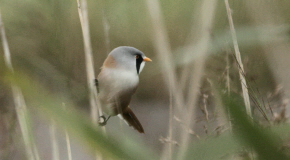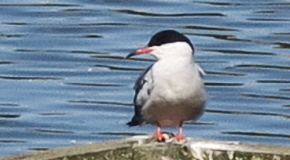 The
group makes trips to look at birds, with occasional
meetings to learn and discuss. The
group makes trips to look at birds, with occasional
meetings to learn and discuss.Group Coordinator: Derek Harwood (click to contact) |
| When Two visits a month. One will be
more of a local visit, the other may be further
afield. So one should be shorter in duration, the
other longer, generally.
|
| Where Good places to look at birds and
enjoy nature in or near London and slightly
further afield.
|
The iU3A Birdwatching group was established
in December 2014, and we now have over fifty signed up
members, ranging from complete beginners to a few with
several years' experience of birdwatching. However,
generally there are no more than about six on each visit.
New members are welcome, whatever their level of
expertise. We also welcome anyone with a broad interest in
nature, wildlife or other aspects of the countryside which
they would like to share or extend. Group members share
ideas they have for outings, and we do our best to follow
up all of them.
The emphasis is very much on getting out and
enjoying nature and birds in particular. We may also have
a few indoor meetings from time to time to share
experiences and perhaps also to hear expert speakers. It
depends entirely on what the group would like.
If you want to join the group and you are
already a iU3A member then you can sign up through Beacon
here. If you are not a member of
Islington U3A then you need to join that firstly. Go to
the Join Us web page and
download the Membership form.
Friday 24 October (JD), Stokers Lake: Meet at Marylebone Train Station by 9.45am to catch the 9.56am Chilterns Railways train to Rickmansworth — gets us there at 10.19am. There are frequent trains back. Rickmansworth is within the Freedom Pass area, so no train ticket necessary. No need to book, but if you decide to catch the train at Harrow-on-the-Hill (10.08am) or come via Metropolitan line which takes 45 mins. from Kings Cross, please meet the group at Rickmansworth station at 10.20am. It’s a short walk to the reserve. We can decide among us how long we stay but probably a couple of hours will do us. There is a cafe and toilets by the lake on our way back to the station. Just turn up on the day.
Monday 3 November (JD), Regents Park: The next iu3a local visit will lead us on a stroll in Regent's Park to look at the heronry, the ducks and perhaps the nesting peregrines. Meet at 10.00am outside Great Portland Street tube. You can also get there by buses 30 and 205 or it's a very short walk from Regents Park tube. Regent's Park is a surprisingly good place for birds, and at this time of year hopefully there will also be some summer visitors to try to pick out — blackcaps and chiffchaffs for example. See here: https://www.royalparks.org.uk/regents-park. This is a local visit, organised to fit in between our main outings, so will only last a couple of hours. Just turn up on the day.
Friday 28 November (JD/DH), Wanstead Park: This will be a morning stroll from Wanstead Park Overground, quickly reached from H&I, across the Flats and Park to Wanstead Underground. On the Flats we may see winter thrushes such as fieldfares, and winter flocks of tits and finches. In the Park, there will be ducks and water birds, with always the chance of something unusual. We'll meet at 9.20am at H&I station, to get the Victoria line to Blackhorse Road where it is an easy change to the Overground for a short journey on to Wanstead Park. For those starting from a different point, please get to Blackhorse Road to get the 9.51 Overground train to Wanstead Park. Depending on how it goes, we'll have a late coffee or an early lunch around Wanstead before heading back. Send me an email if you intend to attend.
Other Provisional Dates, and locations, for 2026:
To be set yet.
2017-18 look here
2018-19 look here
2019-20 look here.
To help plan your own trips, or to inspire suggestions for our visits, you might want to look at the London Bird Club Wiki here. To enjoy our bird visits to the maximum you will need decent binoculars (8×25 or 8×42 or 10 x 42 or 10 x 50 are good). The first number tells you the magnification (ie 8 or 10 times bigger), the second number is the size of the 'objective' (larger) lens which determines the amount of light (sharpness) of the image. Bigger numbers also mean bigger weight. There are also two forms — porro prism (offset lenses) or roof prism (in-line lenses). Porro type are generally cheaper but larger/heavier. Appropriate footwear and rain gear if the weather threatens. Each of our visits will have a maximum of 10 participants (but normally we are a lot less than that).
Birds on the Edge — see here for information of birds at risk. To read the quarterly magazine from WWT, click here.
Also see the following link here to the local RSPB web page regarding their recent visits (to be updated).
To follow what the London Wildlife Trust are up to have a look here.
If you want to hear some particular bird song or call try using this site: here.
And to end, just a bit of humour, have a look at this video clip here. And another one: here.
What can you see in your back garden? See some goldfinches here.
Blogs
This sections provides some learning material in bite-size easy format. They are in no particular order.
- Seeing Red (redwings, redstarts and redshanks) here
- Preying (identifying between birds of prey) here
- Gulling About (or more about gulls) here
There will be no further reports for recent visits.
For a record of our other visits you can see the reports by the following links:
site designed by Gill Hopkins
logo designed Tattersal
Hammarling & Silk
registered charity number 1157067
 islington
islington


